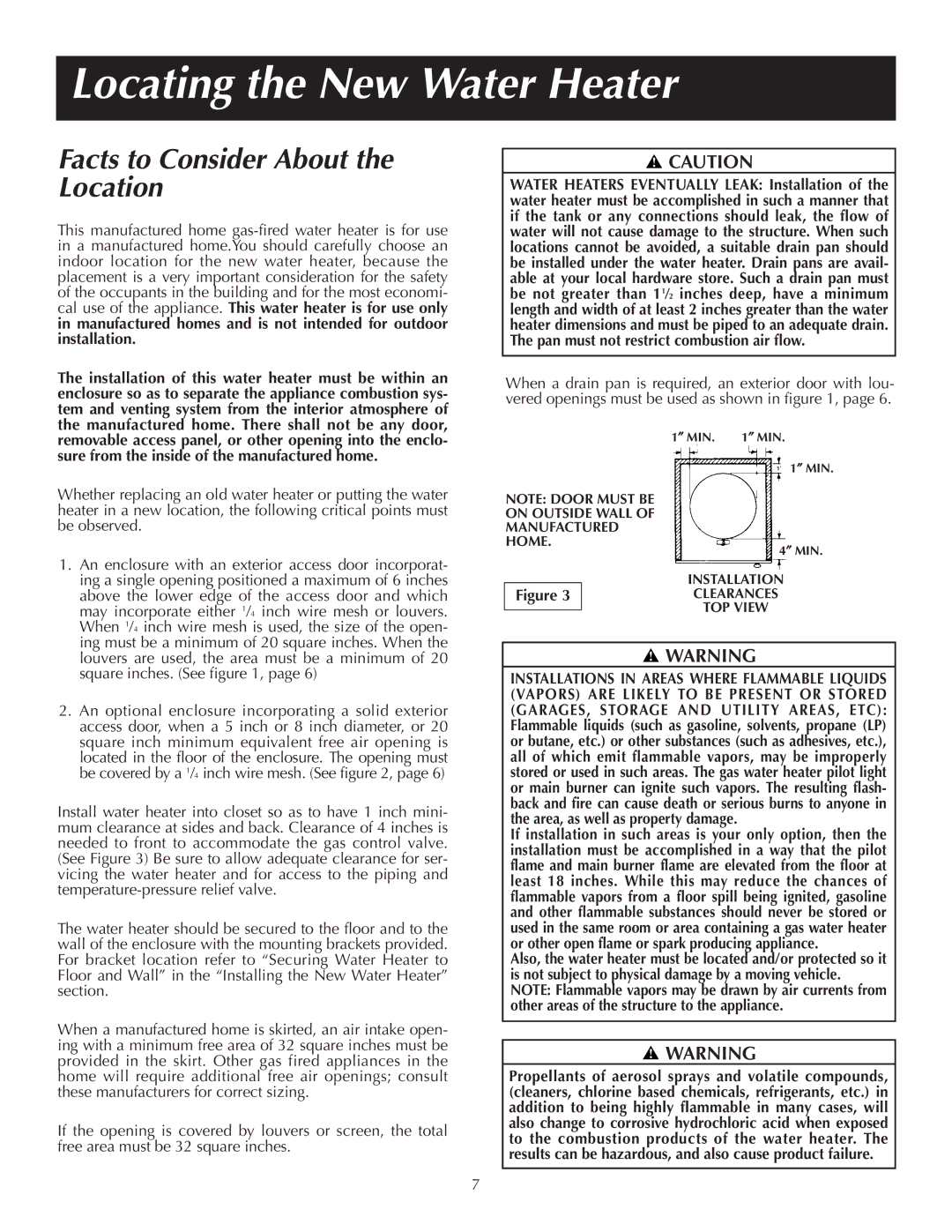
Locating the New Water Heater
Facts to Consider About the Location
This manufactured home
The installation of this water heater must be within an enclosure so as to separate the appliance combustion sys- tem and venting system from the interior atmosphere of the manufactured home. There shall not be any door, removable access panel, or other opening into the enclo- sure from the inside of the manufactured home.
![]() CAUTION
CAUTION
WATER HEATERS EVENTUALLY LEAK: Installation of the water heater must be accomplished in such a manner that if the tank or any connections should leak, the flow of water will not cause damage to the structure. When such locations cannot be avoided, a suitable drain pan should be installed under the water heater. Drain pans are avail- able at your local hardware store. Such a drain pan must be not greater than 11⁄2 inches deep, have a minimum length and width of at least 2 inches greater than the water heater dimensions and must be piped to an adequate drain. The pan must not restrict combustion air flow.
When a drain pan is required, an exterior door with lou- vered openings must be used as shown in figure 1, page 6.
1″ MIN. | 1″ MIN. |
Whether replacing an old water heater or putting the water heater in a new location, the following critical points must be observed.
NOTE: DOOR MUST BE ON OUTSIDE WALL OF MANUFACTURED HOME.
1″ MIN.
4″ MIN.
1.An enclosure with an exterior access door incorporat- ing a single opening positioned a maximum of 6 inches above the lower edge of the access door and which may incorporate either 1/4 inch wire mesh or louvers. When 1/4 inch wire mesh is used, the size of the open- ing must be a minimum of 20 square inches. When the louvers are used, the area must be a minimum of 20 square inches. (See figure 1, page 6)
2.An optional enclosure incorporating a solid exterior access door, when a 5 inch or 8 inch diameter, or 20 square inch minimum equivalent free air opening is located in the floor of the enclosure. The opening must be covered by a 1/4 inch wire mesh. (See figure 2, page 6)
Install water heater into closet so as to have 1 inch mini- mum clearance at sides and back. Clearance of 4 inches is needed to front to accommodate the gas control valve. (See Figure 3) Be sure to allow adequate clearance for ser- vicing the water heater and for access to the piping and
The water heater should be secured to the floor and to the wall of the enclosure with the mounting brackets provided. For bracket location refer to “Securing Water Heater to Floor and Wall” in the “Installing the New Water Heater” section.
When a manufactured home is skirted, an air intake open- ing with a minimum free area of 32 square inches must be provided in the skirt. Other gas fired appliances in the home will require additional free air openings; consult these manufacturers for correct sizing.
If the opening is covered by louvers or screen, the total free area must be 32 square inches.
INSTALLATION
Figure 3CLEARANCES
TOP VIEW
![]() WARNING
WARNING
INSTALLATIONS IN AREAS WHERE FLAMMABLE LIQUIDS (VAPORS) ARE LIKELY TO BE PRESENT OR STORED (GARAGES, STORAGE AND UTILITY AREAS, ETC): Flammable liquids (such as gasoline, solvents, propane (LP) or butane, etc.) or other substances (such as adhesives, etc.), all of which emit flammable vapors, may be improperly stored or used in such areas. The gas water heater pilot light or main burner can ignite such vapors. The resulting flash- back and fire can cause death or serious burns to anyone in the area, as well as property damage.
If installation in such areas is your only option, then the installation must be accomplished in a way that the pilot flame and main burner flame are elevated from the floor at least 18 inches. While this may reduce the chances of flammable vapors from a floor spill being ignited, gasoline and other flammable substances should never be stored or used in the same room or area containing a gas water heater or other open flame or spark producing appliance.
Also, the water heater must be located and/or protected so it is not subject to physical damage by a moving vehicle. NOTE: Flammable vapors may be drawn by air currents from other areas of the structure to the appliance.
![]() WARNING
WARNING
Propellants of aerosol sprays and volatile compounds, (cleaners, chlorine based chemicals, refrigerants, etc.) in addition to being highly flammable in many cases, will also change to corrosive hydrochloric acid when exposed to the combustion products of the water heater. The results can be hazardous, and also cause product failure.
7
